Ellis Shuman's Blog, page 25
September 11, 2019
The Stupidest Carwash I Ever Did

Cape Kamenjak – a coastline of coves and beaches at the southernmost tip of Croatia’s Istrian Peninsula. I park our rental car and we stroll down to the warm waters of the Adriatic Sea. After an afternoon on the beach, we return to the car. It is blanketed in dust and sand.
I am embarrassed at how dirty the car is. How can I drive it like this? I don't want to be seen as a snobbish tourist with no regard for a vehicle’s appearance. I can’t return it to the agency in this condition!
We drive north, bound for the hilltop village of Motuvan. A small sign at the side of the road catches my eye. It’s a carwash! I slow down and pull in. The cost is only a few Croatian kuna so, why not? A few minutes later, we are back on the road in a sparkling clean car. Little did I know what awaited us.
At home, I enjoy the effort, I tell myself, as I struggle up the hill with heavy buckets of water to where my car is parked. Oh, one other thing I forgot to mention. In Israel, where water is precious, we take all possible steps not to waste it (or at least I do). One shouldn’t use a hose to wash a car, or so I believe. I lift up a bucket and throw water on the car and then scrub off the grime with soap and brush. Another bucket and the car is clean.
Well, somewhat clean.

When I splurge on a more professional job, I drive to Abu Gosh, the Israeli Arab village near my home. Recently, I arrived at the small lot early on a Friday morning. I was the first customer of the day. Two young boys attacked my car with vigor, vacuuming and washing with a power spray. Their boss, a teenager maybe a few years older, sat at his outdoor desk playing with his phone. When the car was finished, he got up to inspect the work of his employees. He then sprayed a mist on the car's four hubcaps and seemed pleased at how this made them shine.
It only cost 50 shekels ($14) to get the car washed, inside and out. The end result, as far as I could see, was good. The car was clean. But I could have done it myself!
Back to Croatia
After the carwash, my rental vehicle is as good as new. Now we can continue on our journey. A short while later we see the sign indicating the direction to Motuvan. But there’s another sign. Construction work ahead. For 15 kilometers. The road is unpaved. Gravelly.
As I drive, slowly, the car tires kick up the dirt, covering the car in a new layer of dusty brown. When we arrive at the parking lot at the bottom of the Motuvan hill, the car is as filthy as it was at the beach. Maybe even dirtier.
A clean car lasts for a fleeting moment. It makes you, the driver, feel good, but you know that the feeling won’t last. Don’t despair! The next carwash is just down the road. Or you can always use a bucket.
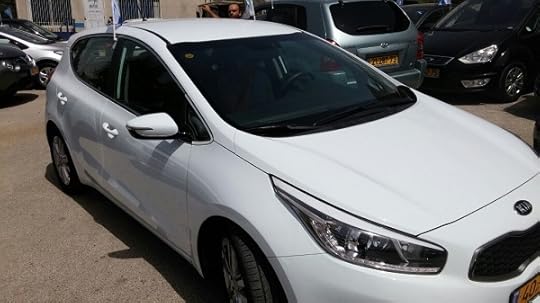 Our car, clean for now.
Our car, clean for now.
Published on September 11, 2019 01:57
September 4, 2019
The Seven Rila Lakes and Many More

I first visited Bulgaria’s Seven Rila Lakes in June 2010, hiking through meadows lush with purple crocuses and across plains blanketed in six inches of snow. One moment the summer sun was on my back and the next I felt like an Arctic explorer. It was a surreal experience, certainly one of my best hikes ever.
My dream of going back to the lakes came true this year. I returned to Bulgaria eager to see more spectacular vistas, to climb more mountains, and to experience new adventures. I would not be disappointed.
The Rila Lakes, each one more stunning than the next, are located in the Rila Mountains about two hours south of Sofia. I joined an eight-day "Hiking trek in the Pirin and Rila mountains,” organized by Traventuria, a Bulgarian company with a well-earned excellent reputation for its hikes and tours. I set forth with seven other hikers from around the world and a local guide.
The first thing I learned upon my return to the Seven Rila Lakes was that “seven” is far from an accurate count. The Rila Mountains are spotted with more than 200 glacial lakes. My hike would give me a brief view of only a small number of them.

The Pionerska chairlift to the starting point of the Rila hike is an adventure in itself - more than twenty minutes on an open seat going over beautiful forest landscape. The lakes are a popular destination, attracting not only experienced hikers but families and visitors of all ages. The area tends to be quite crowded in the summer months, especially on weekends, but the higher we hiked, the less people we encountered.

On my first visit we had only hiked as far as the fourth lake, which was frozen solid at the time. There was too much snow on the ground and it was too cold to venture further, and this was in the month of June! This time around, the only snow we saw was in small off-white patches in the distance.
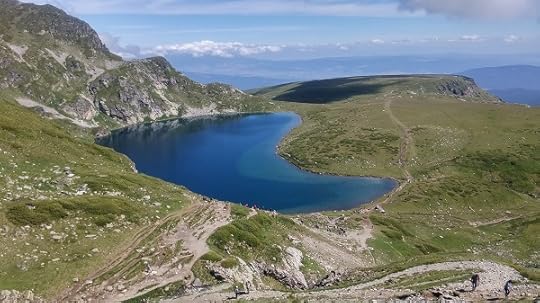
We hiked up the steep slopes, passing each lake in turn. Each lake has a name characteristic to its shape or one of its features. The Lower Lake; the Fish Lake; the Trefoil; the Twin; the Kidney; the Eye; and the Tear. The lakes reflected the surrounding mountains and from above, they were brilliantly blue in color. At one high point you can take in a panoramic view of several of the lakes laid out below you, just waiting to be captured in an amazing photograph.

Our hike did not stop at the highest of the seven lakes. We continued on the paths of the Seven Rila Lakes Cirque, higher and higher, along narrow ledges and also across wide grassy meadows. Each ascent was steeper than the last. We took well-deserved breaks while gazing at the breathtaking scenery. Towering mountains with their craggy slopes, hidden valleys, pristine lakes in shades of turquoise and green—all of Bulgaria’s wondrous natural beauty made the challenging climb totally worthwhile.

We climbed to the Malyovitsa peak and along mountain ridges overlooking the picturesque Rila Monastery, so tiny in the distance that you could almost miss it in the thick forest. Along the way we passed by, and above, additional glacial lakes, different in size and shape and surrounded by the amazing Rila terrain. We made our way down the Malyovitsa Valley, considered the “cradle of Bulgarian mountaineering and rock climbing”, to the van awaiting us at journey’s end.

Visiting Bulgaria’s Seven Rila Lakes for the second time, climbing the surrounding mountains to the highest peaks and viewing the incredible panoramic views—all of this served to whet my appetite for further Bulgarian adventures.
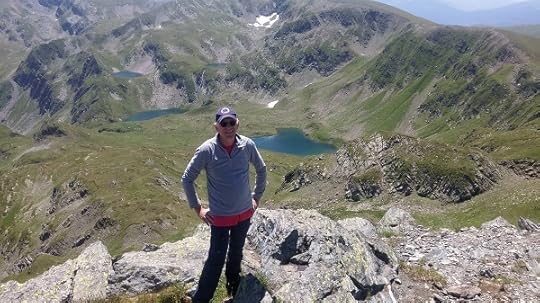
Related articles:
Climbing Mt. Vihren
Hiking in Bulgaria - Trek of a Lifetime
Published on September 04, 2019 21:48
August 21, 2019
Climbing Mt. Vihren
I had never heard the word ‘scrambling’ before. In the dictionary, ‘scrambling’ is defined as “to move or climb quickly but with difficulty, often using your hands to help you.” This was certainly the case when I struggled up the rough, steep slopes of Mt. Vihren, in Bulgaria’s Pirin Mountains.

It was the second day of an eight-day "Hiking trek in the Pirin and Rila mountains”. The trip was organized by Traventuria, a Bulgarian company with a well-earned excellent reputation for its hikes and tours. The planned route for the first day had been changed due to heavy cloud cover on the higher peaks. Instead, we took an easier hike through pristine pine forests, at one point reaching Hut Yavorov at an elevation of 1,740 meters above sea level.
That first day’s hike was for me, anything but easy. Making my way up the forest paths, my leg muscles ached, the pain increasing the higher we climbed. “I think I bit off more than I can chew,” I said to myself. Was I really fit enough to do this? Was I capable of climbing Bulgaria’s highest mountains?
“The only thing that prepares you for hiking, is hiking,” my fellow hikers told me. I persevered and picked up my pace. When we reached the end of our ascent, I took a deep breath. I can do this, I realized. By the next day, luckily, I barely felt any discomfort in my muscles. I was good to go for the day’s mountain climb.

We began to climb
Mt. Vihren is the highest peak of the Pirin Mountains, the second highest in Bulgaria. Our overnight stay had been at Bansko, a small Bulgarian town at the foot of the Pirins better known for its winter proximity to some of the country’s most popular ski slopes. We set off through green meadows filled with brilliant wildflowers. We followed well-marked paths which ran through fields of huge boulders. Balancing oneself on the uneven stones was extremely difficult. We began to climb.

The higher we went, the thicker the fog. We made our way up the path in the reduced visibility. Pockets of snow marked the slopes of the nearby mountains. It was getting colder. Windier.

We began the final ascent. This part of the mountain was fully exposed to the elements. It was hard to see anything beyond the white cloud that surrounded us. The climb became harder. I caught my breath and climbed ten meters before stopping to again take deep breaths. Was it the lack of oxygen? Or was it my age that was slowing me down? I can do this, I told myself. I pressed on, ever upward.
Up the mountain on all fours
I wore four layers – a T-shirt, fleece, heavy winter coat, and a windbreaker jacket which I had purchased in Sofia before the hike. Luckily, I also bought a pair of gloves. They played an invaluable role as I grabbed one sharp boulder after another. I struggled up the steep slope on all fours.
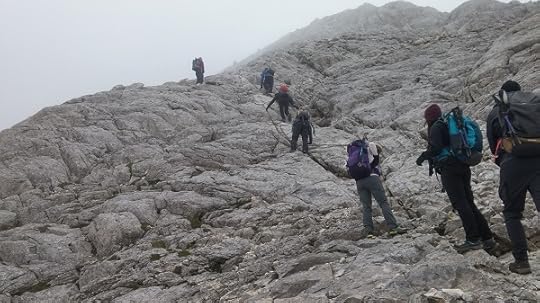
A thick metal cable ran alongside the path. I grabbed on, pulling myself upward. Holding on for dear life. A few final pulls and I reached the top. I joined my hiking companions near a sign announcing that we had reached Mt. Vihren’s peak, at 2,914 meters (9,560 ft) above sea level.
I had made it to the top. Despite the strong wind, the near-freezing temperature, and my aching muscles - I had climbed Mt. Vihren!


For a moment, the wind calmed down and I removed one layer of clothing. We took a group photo, had a quick snack, and prepared for our descent, which luckily would be down an easier route.
And then it began to rain.

Related article:
Hiking in Bulgaria - Trek of a Lifetime

It was the second day of an eight-day "Hiking trek in the Pirin and Rila mountains”. The trip was organized by Traventuria, a Bulgarian company with a well-earned excellent reputation for its hikes and tours. The planned route for the first day had been changed due to heavy cloud cover on the higher peaks. Instead, we took an easier hike through pristine pine forests, at one point reaching Hut Yavorov at an elevation of 1,740 meters above sea level.
That first day’s hike was for me, anything but easy. Making my way up the forest paths, my leg muscles ached, the pain increasing the higher we climbed. “I think I bit off more than I can chew,” I said to myself. Was I really fit enough to do this? Was I capable of climbing Bulgaria’s highest mountains?
“The only thing that prepares you for hiking, is hiking,” my fellow hikers told me. I persevered and picked up my pace. When we reached the end of our ascent, I took a deep breath. I can do this, I realized. By the next day, luckily, I barely felt any discomfort in my muscles. I was good to go for the day’s mountain climb.

We began to climb
Mt. Vihren is the highest peak of the Pirin Mountains, the second highest in Bulgaria. Our overnight stay had been at Bansko, a small Bulgarian town at the foot of the Pirins better known for its winter proximity to some of the country’s most popular ski slopes. We set off through green meadows filled with brilliant wildflowers. We followed well-marked paths which ran through fields of huge boulders. Balancing oneself on the uneven stones was extremely difficult. We began to climb.

The higher we went, the thicker the fog. We made our way up the path in the reduced visibility. Pockets of snow marked the slopes of the nearby mountains. It was getting colder. Windier.

We began the final ascent. This part of the mountain was fully exposed to the elements. It was hard to see anything beyond the white cloud that surrounded us. The climb became harder. I caught my breath and climbed ten meters before stopping to again take deep breaths. Was it the lack of oxygen? Or was it my age that was slowing me down? I can do this, I told myself. I pressed on, ever upward.
Up the mountain on all fours
I wore four layers – a T-shirt, fleece, heavy winter coat, and a windbreaker jacket which I had purchased in Sofia before the hike. Luckily, I also bought a pair of gloves. They played an invaluable role as I grabbed one sharp boulder after another. I struggled up the steep slope on all fours.

A thick metal cable ran alongside the path. I grabbed on, pulling myself upward. Holding on for dear life. A few final pulls and I reached the top. I joined my hiking companions near a sign announcing that we had reached Mt. Vihren’s peak, at 2,914 meters (9,560 ft) above sea level.
I had made it to the top. Despite the strong wind, the near-freezing temperature, and my aching muscles - I had climbed Mt. Vihren!


For a moment, the wind calmed down and I removed one layer of clothing. We took a group photo, had a quick snack, and prepared for our descent, which luckily would be down an easier route.
And then it began to rain.

Related article:
Hiking in Bulgaria - Trek of a Lifetime
Published on August 21, 2019 22:00
August 14, 2019
Review of "The Burgas Affair" on Turning Another Page
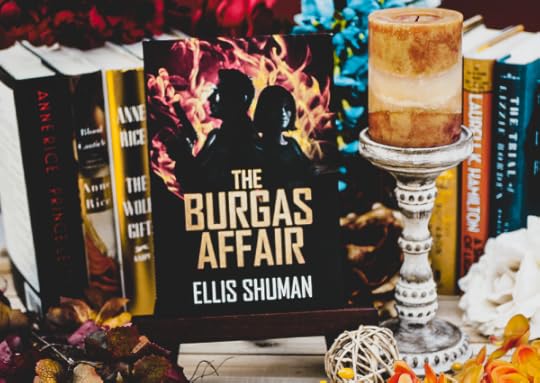
Shuman brings two characters with differing backgrounds into a crime investigation for a common goal, to solve the case and keep the civility among their people. His characters are exceptional, with many faults and likable qualities as well.
The pace is steady and the story is action-packed, making it easy to get wrapped up in. While there are a few grammatical errors here and there, this should not hinder enjoyment of the novel at all. The author does inform the reader that the characters are purely fiction; however, the story is based on a true event.
Terrorism is an ever evolving threat to many countries and the information conveyed in this story is quite credible. Readers will achieve a clear understanding of the strength that many have in the face of fear and we will say that it is a story worth reading. For any who tend to lean toward thrillers and crime, this one may be of interest to you.
Read the full review on Turning Another Page.
Published on August 14, 2019 22:12
August 6, 2019
Hiking in Bulgaria - Trek of a Lifetime

I first visited the Seven Rila Lakes in June 2010. To my amazement, I found myself walking in a few inches of snow alongside mountain meadows full of brilliant purple crocuses. At times I wore a T-shirt and at times I put on a long-sleeved shirt as I hiked through terrain that appeared to be lifted straight out of Antarctica. The views were stunning, the air was fresh, and despite some of the steep uphill slopes, I enjoyed every moment of it.
My friends and I only made it to the fourth of the seven lakes; it was frozen solid, even in the middle of June! The rest of the way was impassable because of the snow. I promised myself I would come back one day. I dreamed of taking another incredible Bulgarian hiking trek. And then, nine years later, my dream came true.
Right away I realized that I was the least-experienced of the hikers. My daily routine in the gym and even my participation in Tel Aviv and Jerusalem marathon races had not prepared me for the hike. “The only thing that prepares you for hiking, is hiking,” I was told. My leg muscles ached on the first day. I wondered if I had bitten off more than I could chew. Yet, I quickly adapted to the pace and got past the muscle aches. I may have been the oldest member of our group, but I wasn’t always the slowest. But often I fell behind the others as I couldn’t stop taking pictures of the astonishing views around me.
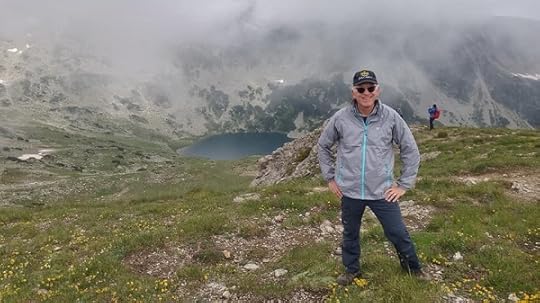
Bulgaria has been blessed by the wonders of nature – mountains, forests, seashores, plains, waterfalls, caves, rivers, and more. I had explored much of the country during the two years I lived in Sofia, but except for that one-day visit to the Rila lakes, I had not previously taken long hikes in the mountains. My trip to the Piran and Rila ranges this year opened my eyes to scenery and landscapes I could not have imagined.
Hiking in the Bulgarian mountains, and climbing their peaks, was the most challenging physical thing I had ever done in my life. Memories of the trek will last a lifetime and I am glad to share my experiences. One thing must be noted, though. None of the photos I took can ever do justice to how beautiful, how stunning, how majestic Bulgaria is. The photos, along with my words, can give you only a small taste of that beauty. Hopefully, you will be encouraged to follow my footsteps and go hiking in Bulgaria.

Published on August 06, 2019 22:46
July 21, 2019
Going Back to Sofia

I make my way through Passport Control, fetch my suitcase, and catch a taxi. Minutes later I am speeding down the traffic-filled streets, behind the trams and the trolleybuses. The taxi crosses Eagles’ Bridge and we are on the cobblestoned streets of the center of the city. Moments later I am dropped off at my hotel.
I am back in Sofia and in many ways, I have come back home. I lived in this city for two years. I walked its streets, ate in its restaurants, admired its older buildings, and worked in its high-tech offices. I strolled through the city’s parks and visited its museums. This is a city I know well and I don’t need to consult a map to make my way around.

To my surprise, there are new, green trams clanging their way up the narrow streets. Vitosha Boulevard is a long, restaurant-lined pedestrian mall. There were trams on the street when I lived in the city. The benches in the park near the NDK conference center are crowded with older residents watching boys display their energetic talents skateboarding up and down the stairs. There are Metro stations in the park. There were none ten years ago.


I pass by the Banya Bashi Mosque and the impressive Sofia Synagogue. For some reason I am always attracted to the outdoor Ladies Market. This is where my wife was pickpocketed long ago but I have no hard feelings for the place. I make my way around the crowded stalls and end up purchasing half a kilo of cherries. Mouthwatering, delicious, huge red cherries. When I think of Bulgaria, I can’t help but remember the wondrous taste of its cherries.

I have seen nearly all the tourist sites that Sofia has to offer. The Roman ruins of Serdica. Boyana Church. The National Museum of History. Even the Museum of Socialist Art. But there is one place I haven’t been.
I take an elevator to the ninth floor of the Sense Hotel and walk into its Rooftop Bar. As I drink a cup of cappuccino and eat a slice of tasty cheesecake, I stare out the large glass windows at the cathedral. From above, the late afternoon golden domes are even more brilliant. This is a view I have never seen before. It is a good way to remember the city.

There is something about Sofia that I can’t exactly put into words. This is a city in which I feel comfortable. This is a city where I feel safe. Although I am but a tourist, Sofia is a city I once called home. It is good to be back. It is difficult to leave. Farewell Sofia. Until we meet again.
Published on July 21, 2019 22:26
July 3, 2019
Review of “Is There Anybody to Love You” by Kalin Terziyski
 There’s nothing beautiful about the city of Sofia in Is There Anybody to Love You? by Kalin Terziyski (Dalkey Archive Press, December 2018; translated by David Mossop), a collection of short stories set in the Bulgarian capital. “The houses in Sofia are ugly because they’re old,” thinks the protagonist of the story ‘The Beggar’. “Their age doesn’t do anything to enhance their beauty, just destroys their rendering.”
There’s nothing beautiful about the city of Sofia in Is There Anybody to Love You? by Kalin Terziyski (Dalkey Archive Press, December 2018; translated by David Mossop), a collection of short stories set in the Bulgarian capital. “The houses in Sofia are ugly because they’re old,” thinks the protagonist of the story ‘The Beggar’. “Their age doesn’t do anything to enhance their beauty, just destroys their rendering.”In the title story it is constantly raining, while in ‘Problems with the Cleaner’, “the stifling heat of August lies as heavy as an old carpet.” The rain is so strong in the story ‘A Stroll through Space with Slight Deviations in Time’ that it seems “as if a cursed and evil decision had been made to engulf us in water.” Still, the heavy rainfall can also serve to refresh the air. After a downpour nearly inundates the city, “the sun even comes out—a strange, droll sort of evening sun—just before it hides behind the mountain peak of Vitosha to go on to someplace else.”
In ‘The Case of the Necktie,’ a private detective is preoccupied trying to find his favorite tie when he is hired to take photographs of a cheating husband. This sort of job is so tedious and banal, the detective thinks, that he would prefer to sell lottery tickets at the train station. “At least that way his life would be filled with more vivid impressions and passions, and he would never be bored.” Little does the detective know that a surprising discovery awaits him in the case.
A journalist is hired to write a travel article in the story ‘Eighty Thousand Leagues under the Ladies’ Market.’ It is supposed to be some sort of “lifestyle article” but did that mean it was to be aimed at the “nouveau rich who dreamed of being isolated from the world?” The journalist heads for the biggest of Sofia’s outdoor markets and takes a seat at a small cafe. “If you sit aimlessly for a few hours in an aimless place, you begin to discover strange things,” he thinks. Through the journalist’s observations we see the gypsies, the Arabs, the madmen, and the market shoppers. Nearby is the closed, nearly sterile Hali market but the journalist realizes “there is nothing decaying [there] and so there is no life.” The journalist leaves the “calm and cheery consumer wilderness” and returns to the Ladies’ Market, where the madmen reign.
There’s something about this story that serves as a metaphor for Sofia itself. You could focus on the glitz and glamour and the nouveau rich, but in these quickly read stories the author introduces us into the lives of the real residents of Sofia’s streets.
Kalin Terziyski was born in 1970 in Sofia, Bulgaria. He earned a doctorate in medicine and practiced psychiatry for several years before becoming a writer. He is the author of several collections of stories and two novels. The short story collection Is There Anybody to Love You , originally published in 2009, is the first of his works to be translated into English. Terziyski is one of the winners of the 2011 European Union Prize for Literature.
Published on July 03, 2019 22:58
June 12, 2019
10 Reasons to Visit Bulgaria This Year

Bulgaria is not on the bucket list of most travelers and many would find it difficult to place the country on a map. This is a shame because Bulgaria is an amazing, underrated travel destination, one that is blessed with stunning natural beauty and an abundance of fascinating places to visit. Listed below are ten of the most compelling reasons to travel to Bulgaria this year.
Sofia. Many visitors start their exploration of Bulgaria in the country’s capital. Sofia has a very Eastern European ambience but everywhere there are signs of that it is quickly adapting to the modern era. Most of the main attractions are in the center, where the Roman ruins of Serdika can be seen in the metro stations. It is hard to miss the gold-domed Alexander Nevsky Cathedral, built to honor Russia’s assistance to Bulgaria in its war of independence from the Ottomans in the 1870s. The stunning Jewish synagogue, the Banya Bashi mosque and the stunning Central Mineral Baths building are all within walking distance of each other.

Rila Monastery. The most popular tourist site in the entire country is located about an hour and half’s drive south of Sofia. In a serene mountain setting, the monastery is named for Ivan Rilski, Bulgaria’s patron saint who lived in a cave at the site. The main church is framed by black and white-striped pillars and its external walls are covered with Biblical-themed frescoes. The church’s interior is dark but welcoming for the many pilgrims who flock there to light candles.

Plovdiv’s Old Town. Plovdiv is one of the oldest cities in Europe, as evident in the archaeological ruins in the city center. Plovdiv’s Roman past can also be seen in the hilltop amphitheater, still used for cultural events today. The city’s main attraction is its Old Town, with mid-19th century mansions colorfully preserved, which today serve as house museums and galleries.

The Black Sea coast. Visitors who prefer to holiday at seaside resorts will enjoy the luxuries of Sunny Beach and Golden Sands, but there are many other sandy beaches on the coast. Two destinations worth visiting are the small towns of Sozopol and Nessebar. Nessebar is home to ruins of some of the earliest churches in the country.


The mountains. Bulgaria’s many mountain ranges attract skiers from all over to the world-class resorts of Bansko, Borovets, and Pamporovo. Skiing is also possible on Mt. Vitosha, the massif that can be seen from almost everywhere in Sofia. Hikers head to the glacial Seven Rila Lakes, a popular destination which may still be covered in ice in late spring.

The villages. The picturesque villages in the Bulgarian countryside give you the impression that little has changed in the last century. In Koprivshtitsa, a village about an hour east of Sofia, you’ll find examples of Bulgarian renaissance architecture from the mid-19th century. Many of the beautifully preserved homes have become ethnographic museums.

The history. The world’s oldest gold jewelry was discovered near Varna and can be seen in the city’s museums. In many areas of the country there are strange mounds that are actually burial tombs of the Thracians, a militant tribal people that ruled the region until the Romans came to power. Spaceship-like Buzludzha, in the Balkan Mountains, is an unfinished monument built by Bulgaria's communist regime. Today it serves as a popular tourist destination.

The culture. The annual Rose Festival is devoted to Bulgaria’s world-leading production of rose oil, used in perfume and other beauty products. The costumes worn at festival times, with each region represented by its own unique motifs, go hand in hand with traditional Bulgarian song and dance.

The food and drink. Bulgaria’s signature dish is Shopska Salata, a variation of the traditional Greek Salad topped with grated white brine cheese. Bulgarian yogurt is without question the best, and healthiest, in the world, and may explain why Bulgarian villagers have an extremely high life expectancy. Bulgarians raise toasts to each other’s health with rakia, a fruit brandy, usually homemade, with an extremely high amount of alcohol.


The cost. Bulgaria is surprisingly affordable, especially for Western tourists. Even luxurious accommodations are inexpensive when compared to prices elsewhere.
The above list includes just ten of the reasons why you should visit Bulgaria this year, but there are many more. Book you holiday in Bulgaria now!

Originally published on The Huffington Post.
Related articles:
10 Amazing Things You Didn't Know About Bulgaria
10 Places You Must Visit in Bulgaria
Published on June 12, 2019 11:09
June 4, 2019
Review of ‘The Book of Jeremiah’ by Julie Zuckerman
 When we first meet Jeremiah Gerstler, he is a mischievous eleven-year-old who sees no harm in releasing spotted frogs on his family’s seder table during the recitation of the Ten Plagues. But Jeremiah is certainly not the delinquent his school’s headmaster claims he is. He’s a boy after all. Although his parents would love to make him a mensch, Jeremiah will find his own way in life.
When we first meet Jeremiah Gerstler, he is a mischievous eleven-year-old who sees no harm in releasing spotted frogs on his family’s seder table during the recitation of the Ten Plagues. But Jeremiah is certainly not the delinquent his school’s headmaster claims he is. He’s a boy after all. Although his parents would love to make him a mensch, Jeremiah will find his own way in life.When we next meet Jeremiah, nearly seventy years have passed. An essay collection on the subject of the international political economy is being published in honor of his 80th birthday. The dedications in the book praise him, not for the academic achievements of his long career, but for the fact that he “does not tolerate academic laziness.”
“‘These you call dedications?’” Jeremiah fumes. The underlying message, he realizes, is that he is being called out for his “mercurial, volatile, and impulsive” nature. When we hear Jeremiah’s remarks at a celebratory gathering, we tend to believe that this description may be totally on the mark.
What makes the book unique, though, is the order in which the stories are presented. After meeting Jeremiah as a boy, and then again as a retired, not always respected professor, we join him at an interview when he is applying for a position with the CIA in 1952. In the aptly titled ‘Clandestiny’ we learn that Jeremiah’s dream is to turn a master’s thesis on U.S. foreign policy into something more than an academic interest. But, as in real life, dreams do not always come true.
Later, but actually earlier in time, we hear the voice of Lenny, Jeremiah’s older brother. In the story ‘Three Strikes’ Lenny prefers to listen to the Yankees-Cubs World Series game on the radio than to hear the Rosh Hashanah shofar. Lenny sneaks off to a neighborhood pharmacy with Jeremiah in tow and much to Lenny’s chagrin, Jeremiah goes missing. The older boy repents for leading his brother astray, but Jeremiah sees the outing as fulfillment of the adventure he was promised.
In ‘Transcendental’, which takes place in 1983, we see things from Jeremiah’s son’s viewpoint. As father and son argue, Stuart lashes out, “Why is it that you don’t feel any emotional ties with me?” Stuart feels that his father is a “hard case” but later realizes that “the old man could teach him a thing or two. Share some of his life experience and talk on a man-to-man level.” As in most of the other stories in the book, things turn out alright in the end.
Set in 1999, ‘The Dutiful Daughter’ follows daughter Hannah and her parents on a trip to Israel. “Hannah longed to relax after a long day of sightseeing, but Jeremiah, in his one-track mind, insisted on talking about work, rambling on about some colleague’s research on labor economics.” Impulsively, Jeremiah sneaks off to meet a Palestinian professor in Ramallah instead of traveling with his wife to meet relatives in Haifa. Hannah realizes that “her father’s persistence, his sheer will to get things done, had served him well in his career.” Although Hannah admits that this can be “an admirable quality,” his “tiresome verbal barrage ... made her want to shoot him.” As readers we are occasionally angered by Jeremiah’s antics as well, but like the distant relative that Jeremiah Gerstler has become, we accept him despite his faults.
You could read the stories included in The Book of Jeremiah in linear order but in retrospect, the order in which they are presented is very satisfying. In ‘Mixmaster’, the last in the collection, Jeremiah finds himself alone in 2009 and taking, of all things, a cooking class. According to the author’s note, after writing this story she “worked backwards (and, at times, forwards) to unravel Jeremiah’s life.” For readers, this bittersweet story, which perfectly ties together everything we’ve learned about Jeremiah Gerstler, is a very appropriate conclusion to a very enjoyable book.
Julie Zuckerman 's fiction and non-fiction have appeared in a variety of publications, including The SFWP Quarterly, The MacGuffin, Salt Hill, Sixfold, The Coil, Ellipsis, MoonPark Review, Crab Orchard Review and others. The Book of Jeremiah was the runner-up for the 2018 Press 53 Award for Short Fiction. A native of Connecticut, she lives in Modiin, Israel.
Buy The Book of Jeremiah and read it now!
Originally posted on The Times of Israel.
Published on June 04, 2019 10:43
May 19, 2019
"The novel moves at a rollicking pace"

Based on the aftermath of the 2012 coach bombing at Burgas in Bulgaria, Ellis Shuman’s fictional thriller, The Burgas Affair (Createspace, 2018), takes us on a roller coaster ride through Bulgaria and the Black Sea coast, following the exploits of a joint Bulgarian/Israeli detective team in tracking down the perpetrators. As such, this is perfect beach reading if you are staying on the Black Sea coast this summer.
Read the full review on talkingthepiste.com
Published on May 19, 2019 21:32



